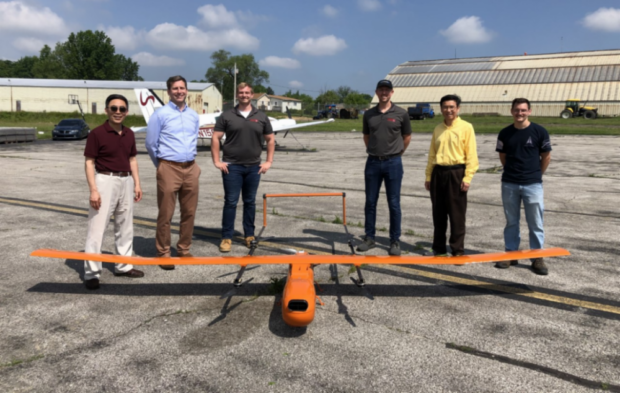a manufacturer of American-made mapping drones, announced the successful completion of a demo flight of the E450, a drone powered by a hydrogen fuel cell on Monday, June 13, at the Kent State University airport.
The demo flight was the culmination of a multi-year project that started in 2020 and was sponsored by the Ohio Federal Research Network (OFRN), a program managed by Parallax Advanced Research. Event 38 partnered with other experts at Kent State University, Case Western Reserve University, the University of Dayton, and Wright State University to explore the possibility of powering drones with fuel cells. The fuel cell used for the project was purchased from Ballard Unmanned Systems, which was acquired by Honeywell in October of 2020.
Fuel cells are a promising power source for drones. Using a fuel cell can extend a drone’s flight time by a significant margin, which is a great advantage. Additionally, because fuel cell power relies on fewer moving parts, drones powered by fuel cell require far less maintenance and are extremely quiet compared to gas-powered drones.
“This team was among the first to experiment with using fuel cells to power fixed-wing, VTOL drones,” said Jeff Taylor, founder and CEO of Event 38. “At Event 38, we’ve been making drones for a decade, so we were very eager to play a role in discovering how fuel cells can shape the future of unmanned flight technology. Plus we recently completed another OFRN project where we integrated a 3D-printed antenna with the E400, our newest fixed-wing mapping drone, so we were excited to be part of another OFRN project.”
In order to accommodate the significant size of the fuel cell, Taylor and the Event 38 team scaled up the design of the E400 to create the E450. They customized the carbon fiber structure of the E450 to fit the fuel cell and tank. They also developed a custom thermal management setup to keep the fuel cell cool while in flight. Design and assembly were conducted entirely at Event 38’s headquarters in Richfield, Ohio, where the company has robust composite prototyping and custom manufacturing capabilities.
Event 38 Principal Engineer Mathew Wright managed integration of the fuel cell and power management systems with the E450’s flight controller and ground control station.
“The autopilot and power system need to be more closely integrated for a fuel cell compared with a battery or gasoline engine,” said Wright. “The power needs to be regulated in real time to optimize for changing power draw and anticipated power bursts to climb or land under VTOL.”
After several years of work, the entire team, along with a representative from OFRN, gathered on Monday, June 13, at Kent State University Airport for a demo flight of the completed drone. The E450 flew successfully for two hours, achieving Level 7 — “system prototype demonstration in a relevant environment” — on the technology readiness level (TRL) scale. Based on an energy use analysis study conducted after the demo, Taylor is confident that the drone could fly for up to 6 hours with a fully pressurized Hydrogen tank.
The success of the project bodes well for the future of fuel cells as a power source for drones.
“In the past, there were a number of drone applications that were deemed impractical because gas and battery power weren’t sufficient due to limited range, noise, or maintenance concerns,” said Taylor. “We’re excited to see which applications we can revisit now that fuel cell power is an option. For example, while Event 38 is not focused on delivery drones, our colleagues in the industry may now be closer to making delivery drones a reality with fuel cell power. Theoretically, if someone wanted to start a drone delivery service with a fleet of Event 38 drones, they could.”
Another exciting possibility is more effective aerial surveillance. Noisy gas-powered drones have to fly high to maintain secrecy. Because fuel cells use electric motors, they’re much quieter and stealthier. An operator can fly the drone low, below the clouds, and use an off-the-shelf sensor to get high-resolution imagery or video. And thanks to the long range of fuel cell power, operators can monitor a site from much farther away.
“In terms of flight time, this drone is truly unmatched among its competitors,” said Taylor. “We’re proud to have been a part of yet another project that’s setting a new standard for drone performance.”
Companies interested in purchasing an E450 can choose between fuel cell, gas, and battery power, based on their specific requirements. The E400, Event 38’s newest fixed-wing VTOL mapping drone, was launched earlier this year and is also available for shorter range missions.
Source: Press Release

